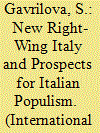| Srl | Item |
| 1 |
ID:
192468


|
|
|
|
|
| Summary/Abstract |
IN THE last few years, the party and political landscape of Europe has changed significantly. In some countries, new parties and movements have moved to the fore. They represent a so-called "political alternative" frequently defined as "new populism" - a sign that the broad masses of the European electorate are dissatisfied with developments within national borders and at the supranational level. Europeans are dissatisfied with migration problems, economic instability, and a host of social issues. This can be found in the platforms of parties that represent what is called the "political alternative," which is a key to their considerable success at the national level and in elections to the European Parliament. In the last decade, the "political alternative" has become an inalienable part of the European party and political landscape,1 yet few of their politicians have reached the highest echelons of power.
|
|
|
|
|
|
|
|
|
|
|
|
|
|
|
|
| 2 |
ID:
177096


|
|
|
|
|
| Summary/Abstract |
This study investigates the potential public demand for investing in electric vehicles infrastructure using a stated preference method. Availability of electric vehicle fast charging stations can improve consumer penetration and acceptance level of purchasing electric vehicles. The outlook of passenger transport is expected to shift to using electricity as the main fuel source which requires a significant amount of energy through the electricity grid and provision of appropriate public charging infrastructure to help support commuter usage. To quantify the preference of users towards an energy related policy, a discrete choice experiment using a virtual payment system was designed to increment an annual levy amount for specific purpose over a set of years. The results from a sample of 1180 households in New South Wales Australia, revealed that depending on the policy setting, 74.2% of the population would be willing to pay some amount of levy. Moreover, we found that on average NSW households are willing to pay $31.9 as annual levy to help raise the fund to develop and install fast charging station state-wide.
|
|
|
|
|
|
|
|
|
|
|
|
|
|
|
|